Follow any of the Shakespear Park trails, and it won’t take you long to understand why it is my favourite amongst the Auckland Regional Parks. Whether you choose to hike over lush green rolling hills, through densely forested areas, or across paddocks, you will be rewarded with panoramic views and beautiful beaches.
There are plenty of things to do at Shakespear Park. It’s an open bird sanctuary, with three main beaches, hours of walking and hiking trails, a waterfall, cows and sheep, a popular campground, and a lookout tower. Open to the public, it’s a gathering spot for families and whanau alike.
Impressive conservation efforts have resulted in reforested areas. Hence, they created a safe haven for many endangered species. And as a result, Shakespear Park received international recognition in June 2019, winning silver in the 2019 International Large Urban Parks Awards. This puts it amongst the world’s best parks, recognizing it as one which feeds the health, environment, and strength of the community.
Situated at the end of the Whangaparaoa Peninsula, Shakespear Park is less than an hour from Auckland’s business district.
As American expats who have been living in and exploring NZ for over 20 years, we see things from both a local’s perspective and from that of a visitor. Therefore, we understand what it’s like to come here and have things be similar, but not always exactly what we are used to. We share the information on this page from this perspective.
Shakespear Park map
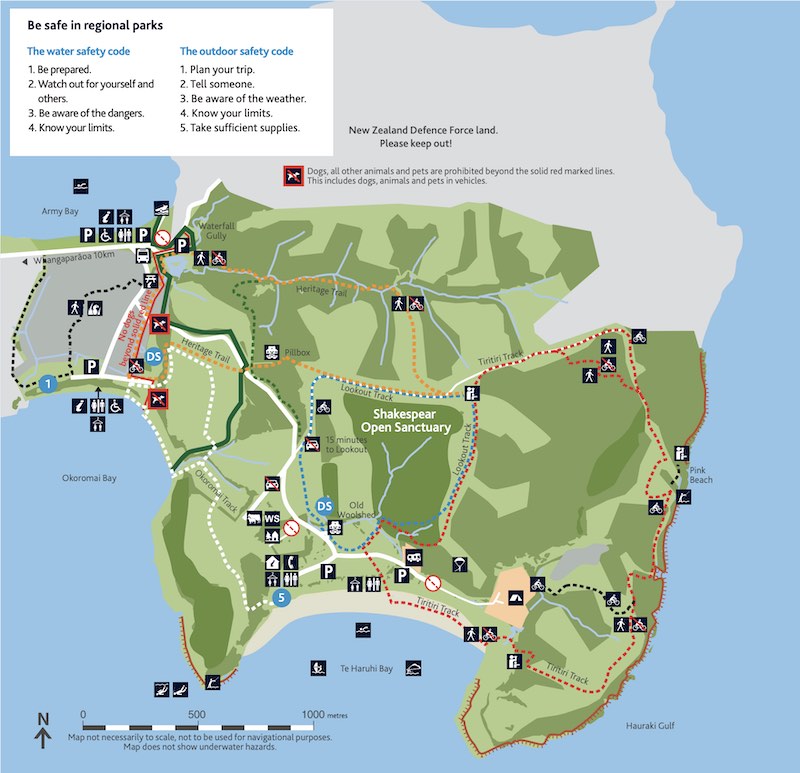
Walks in Shakespear Regional Park
Day hikes in the park
Hours of walking and hiking trails lead to rolling hills, lush forests through farming paddocks, and even a waterfall. The trails are well signposted and range from a five-minute walk to the waterfall gully (from the car park) to a nearly 10km loop. There are trail maps available at the gated entrances.
Each trail has a name and is identified by colour at the trailhead, on the map, and at many of the spots where trails intersect. Trail marker identified as poles with a coloured stripe at the top is found along each path.
From each marker, you can see the next marker, so the trick to staying on a trail is to always look for the next colour marker. The image below shows a marker for a trail section used on both the blue (Lookout Path) and yellow trails (Heritage Trail).
Shakespear is my favourite place to walk in Auckland.
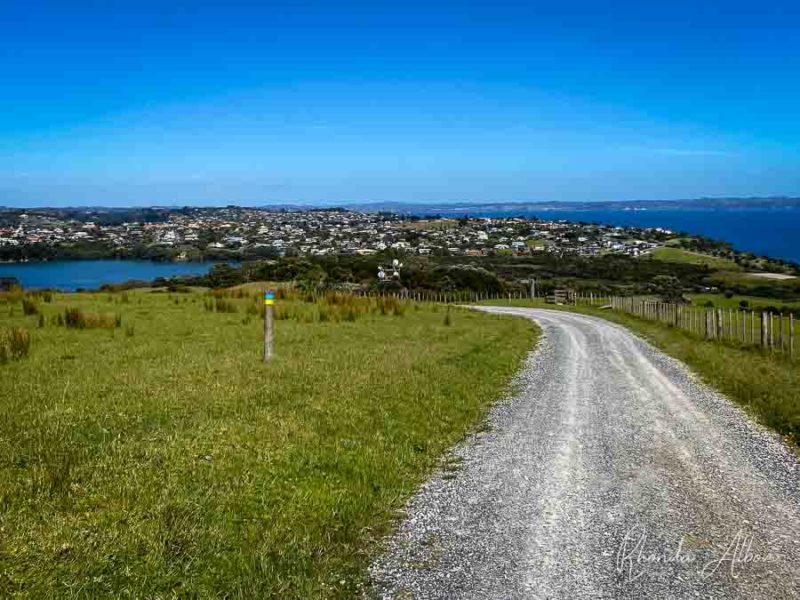
Thanks to some of the SOSSI volunteers, there is now a Shakespear Explorer app that can help you identify some of the park’s treasures as you stroll along the Kaitiaki or Tamariki Trails. It uses GPS and should be downloaded before you arrive, as the park has intermittent internet.
Download your free app from the Apple Store or Google Play.
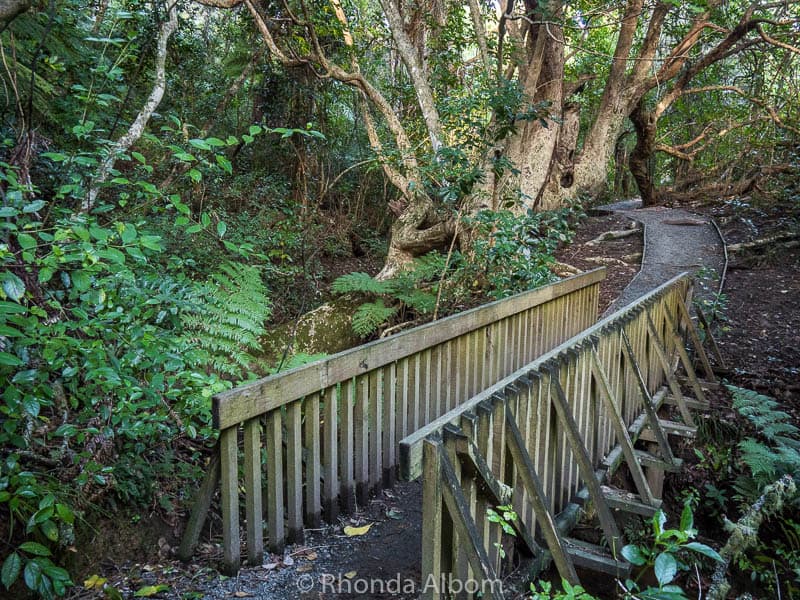
Night hiking in Shakespear Park
Grab a torch (flashlight) and head out to the park for some night hiking. We often spot funnel spiders, sheet web spiders, and New Zealand glowworms. Although much of the park closes to vehicle traffic at dusk, pedestrians can enter, and the waterfall gully car park remains open, allowing easy access into the park.
One of our favourite things to do is to take a night hike to the waterfall, turn off our flashlights, and as our eyes adjust to the darkness, we see the glowworms.
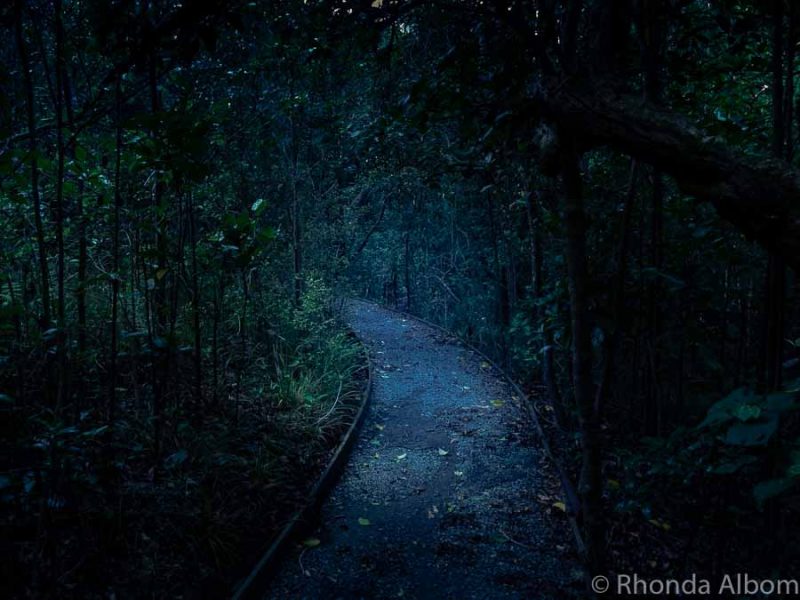
Shakespear beaches
There are three main beaches in the park, plus several smaller beaches, many of which are only available at low tide.
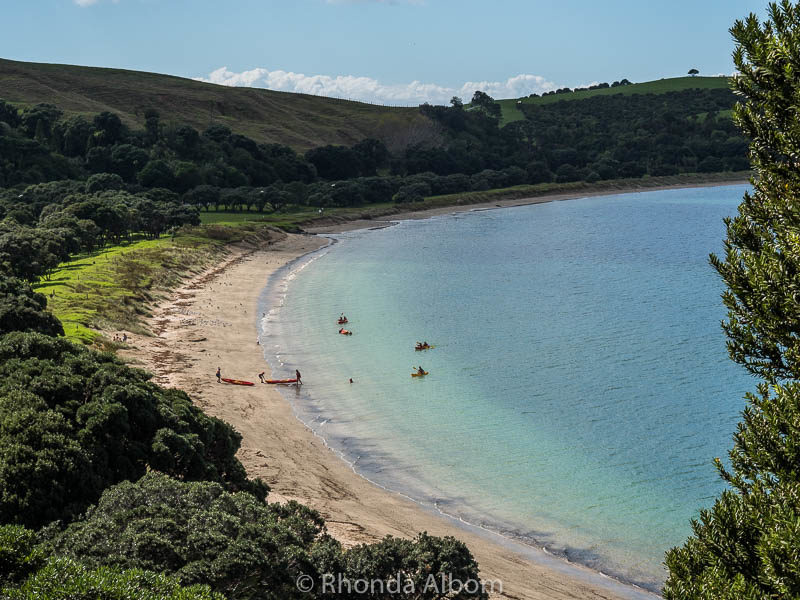
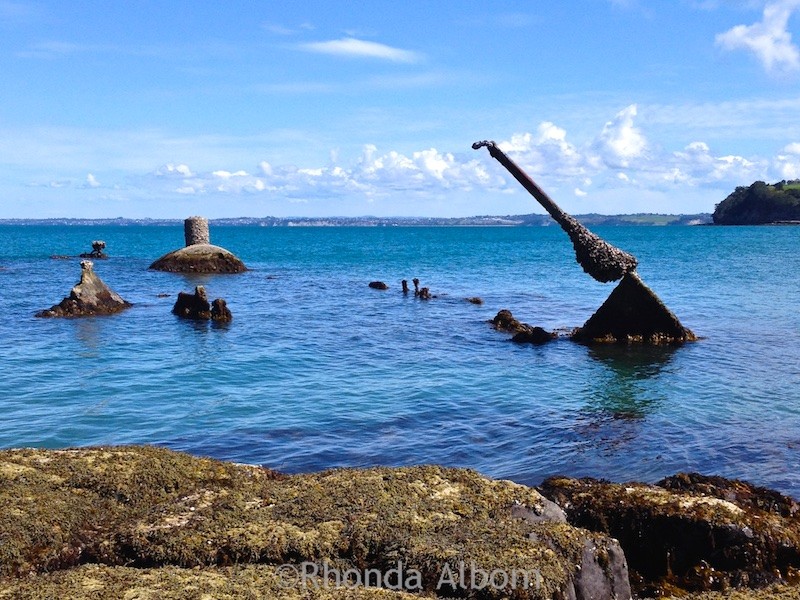
The three main beaches are:
- Te Haruhi: Gentle surf makes this an ideal beach for swimming and kayaking. The most popular of the beaches, as a result, it is often referred to as “Shakespear Beach.”
- Army Bay: used for swimming, boat launch, and occasionally military exercises (this will be well signposted). It is a great place to watch the sunset.
- Okoromai Bay: a very tidal beach, most often used for kite surfing at high tide or collecting cockles at low tide. In fact, Okoromai Bay is one of the few remaining places in Auckland where people can collect cockles to eat. As a result, tight restrictions with huge fines for violations protect the waters from overfishing. Also, there is a sunken ship in Okoromai Bay that is visible during low tide. History buffs can read the entire story here.
One of the more difficult to reach low tide beaches is Pink Beach. Located on the north side of the park, it takes a bit of hiking to get here, so plan ahead based on tide charts.
Shakespear Regional Park camping
Far enough outside the city centre to feel like a real holiday, yet close enough that it’s less than an hour’s drive, Shakespear Park camping is a popular family activity. Facilities include outdoor (cold) showers and flush toilets. The campgrounds require pre-booking through Auckland council.
Due to increased popularity, a second, self-contained only campsite has been established. Book early for Christmas and Easter weekends as it often fills to capacity.
Farm Animals
Electric Fence Warning
Electric Fence Warning: Many of the paddocks have an electric fence. Always identified; however, it is at a height where curious children can grab on. Click here to learn a simple and safe way to test the fence with a piece of grass to see if the power is on or not.
Animals in the Paddocks
Shakespear is one of a handful of Auckland regional parks that have a sheep breeding and farming program, thus allowing everyone an opportunity to experience cows, sheep, and adorable baby lambs. It’s okay to cross the paddocks and mingle with the animals, but stay clear of the baby lambs.
The Hereford cattle are brown and white and were chosen for the park as they are generally people-friendly. The advice if a curious animal approaches you is to ignore it and continue on your way.
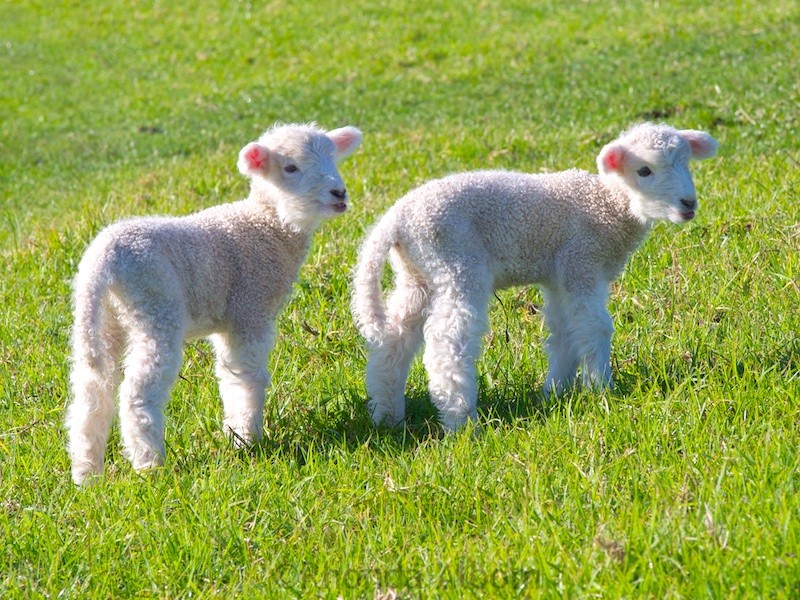
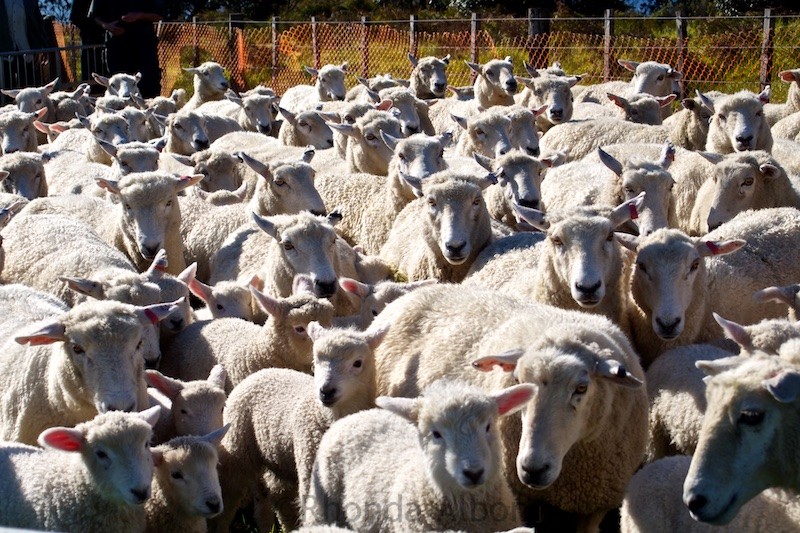
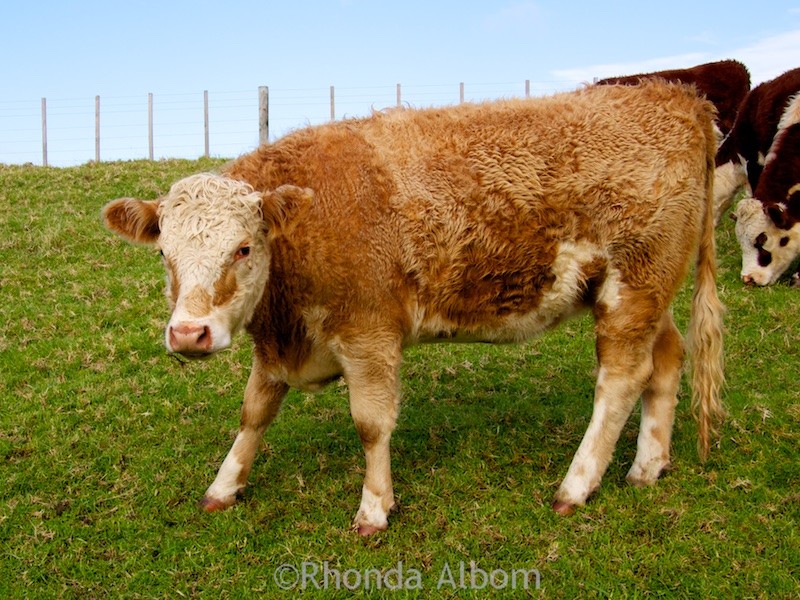
New Zealand Birds at Shakespear Park
Conservation efforts are evident by the completion of the predator-proof fence that protects over 500 hectares of parkland while still allowing people to visit. It converted Shakespeare Regional Park Auckland into open bird sanctuary, similar to that of nearby Tiritiri Matangi Island.
The fence allowed the release of many endangered New Zealand bird species. As a result, the area is now home to a massive and growing bird population that includes endangered dotterels, Tui, whiteheads, robins, pukeko, shags, bellbirds, and even Little Spotted Kiwi Birds.
Learn more about New Zealand birds with this field guide, or carry a pocket bird guide with you when you hike.
Little Spotted Kiwi Birds
With the release of 20 Little Spotted Kiwi Birds in 2017, Shakespear Park became the only mainland home to this breed. This became a possibility in 2011 with the completion of the predator-proof fence. After five years, they knew the fence was effective.
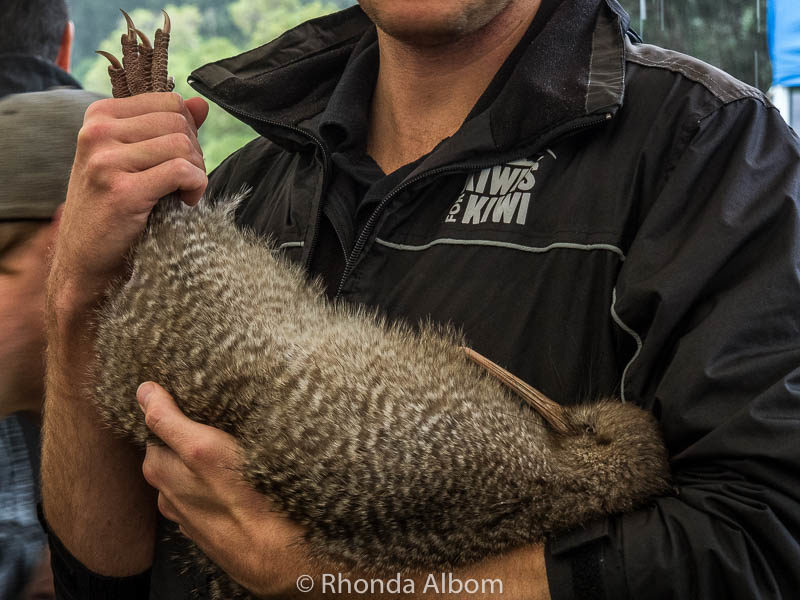
Endangered New Zealand dotterels
New Zealand dotterels breed in spring. Their Māori name is “tuturiwhatu”. They are plovers that grow to only 25 cm (less than 10 inches) in height. You can sometimes spot them on sandy beaches, sand spits, and tidal estuaries on the North Island.
The estimated 1,700 remaining dotterels are protected. If you see them, give them their space, taking photos with a zoom lens from a good distance away.
Check out the Department of Conservation’s official website for more information on these birds.
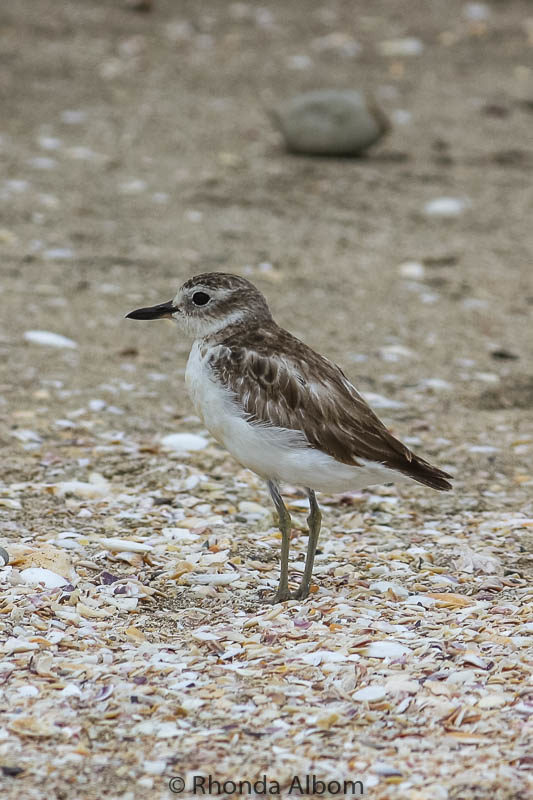
Pukeko
Pukeko, common purple swamphens, wander about, most often in marshy wetlands, low-lying open spaces, and reeds. I have heard visitors describe a Pukeko as a purple chicken, but it’s actually part of the Rail family of bird.
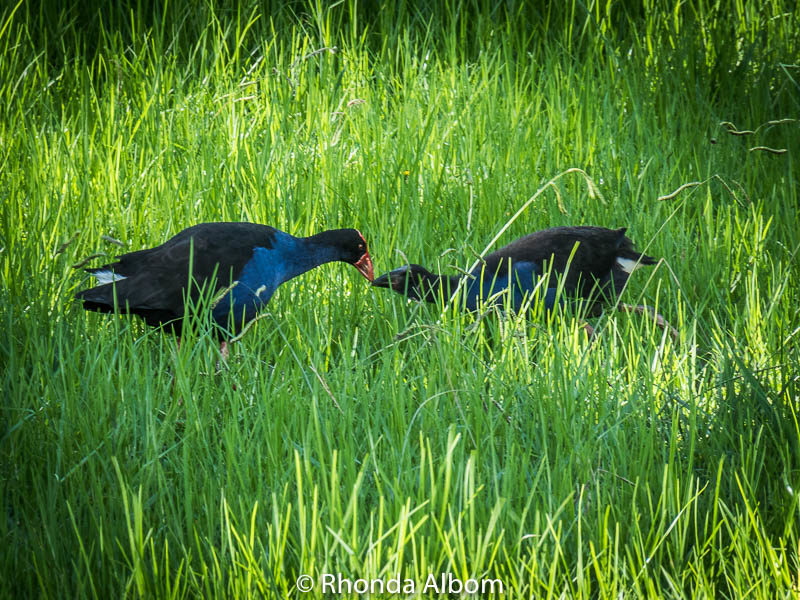
White-faced heron
Native to New Zealand, white-faced herons live along coasts, wetlands, and coastal pastures.
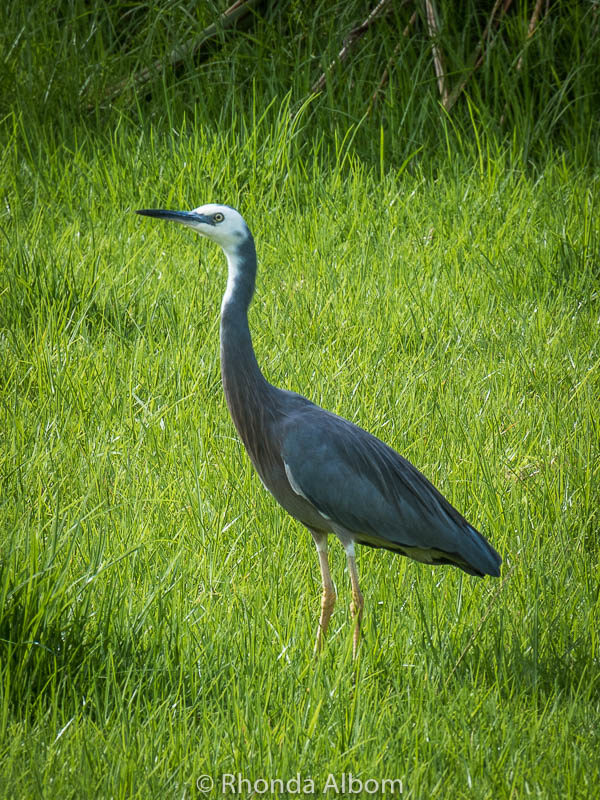
New Zealand Defence force land
A large portion of the park is New Zealand Defence force land and off-limits to visitors. We have been lucky enough to have been invited on several times. However, on the public side of the park, there are a few interesting military remnants like a degaussing station, pillboxes, and anti-tank ditches.
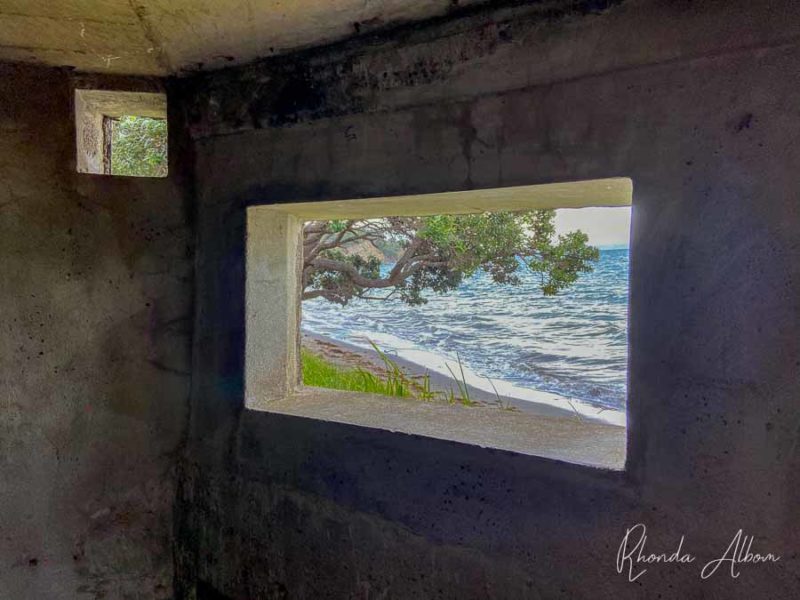
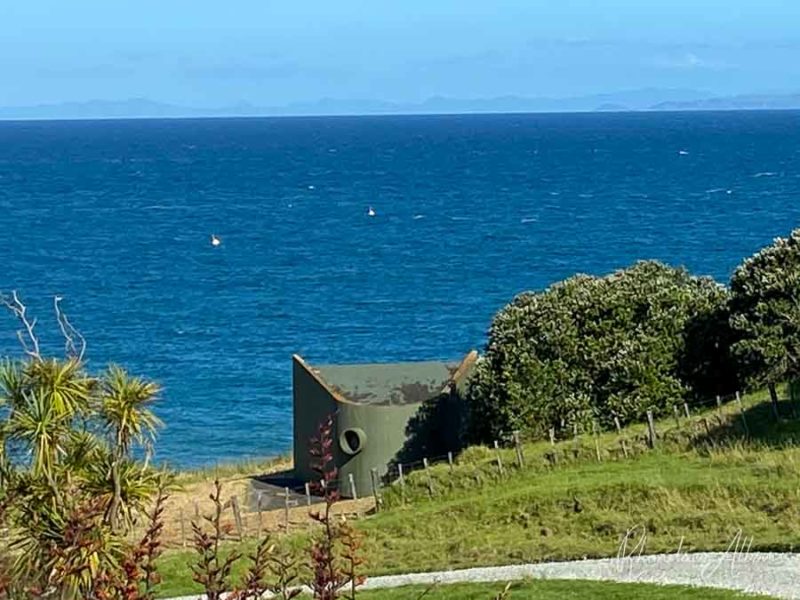
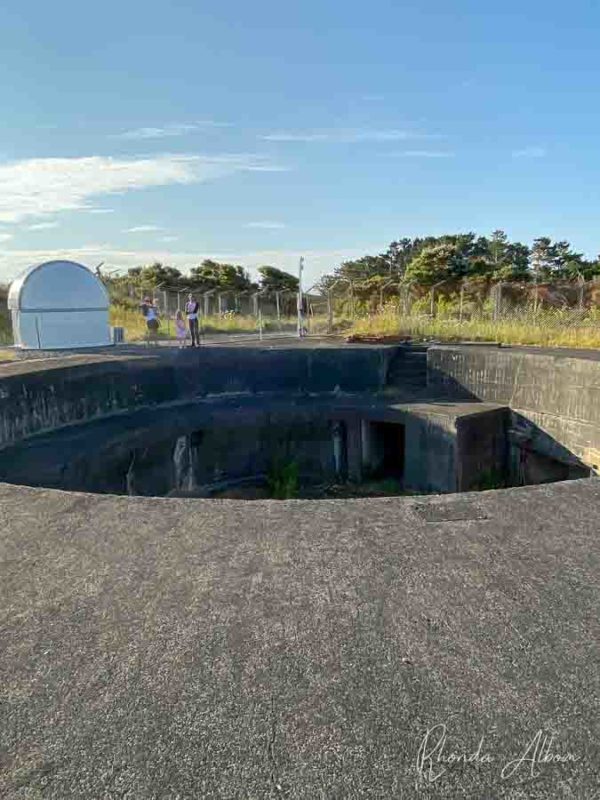
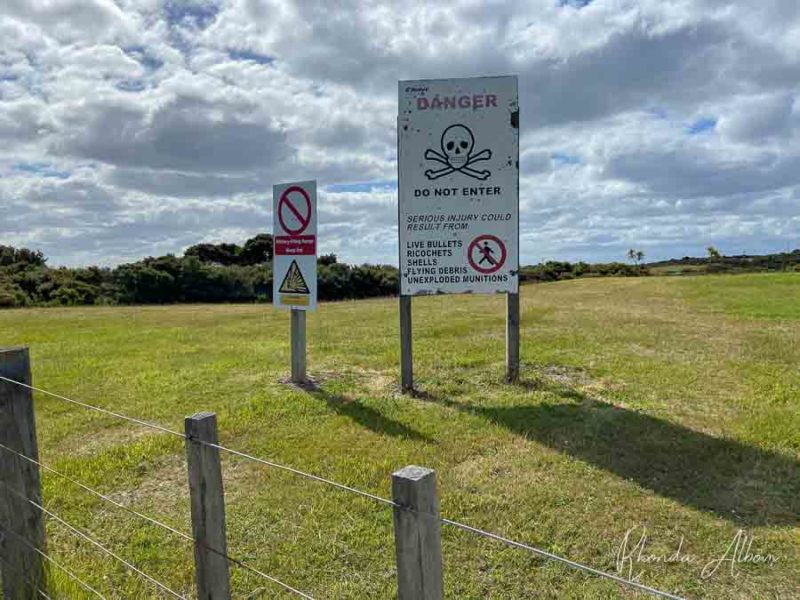
Volunteers at Shakespear Park
An army of volunteers supports the park rangers that both live and work at the park. They look after the animals, maintain trails, plant trees, eliminate pests, clean up after major storms and cyclones, and do anything else that is required to keep the park going. I am proud to be married to one of the weekly volunteers.
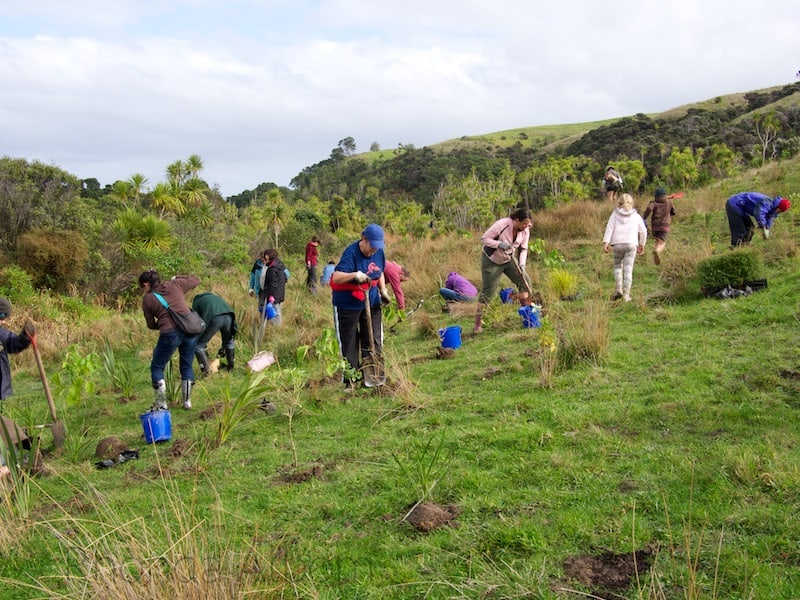
Visiting Shakespear Park
We are lucky to have Shakespear Park in our backyard. It is New Zealand’s most visited and accessible open sanctuary park.
- The park is open all year during daylight hours.
- If you have a car, you can easily drive to Shakespear Park from Auckland city.
- The New Zealand Shakespear (spelt correctly) family purchased the parkland in the late 1800s from the local Maori. They later donated it for use as an Auckland regional park.
- Shakespear is one of several large urban parks in the Auckland region.
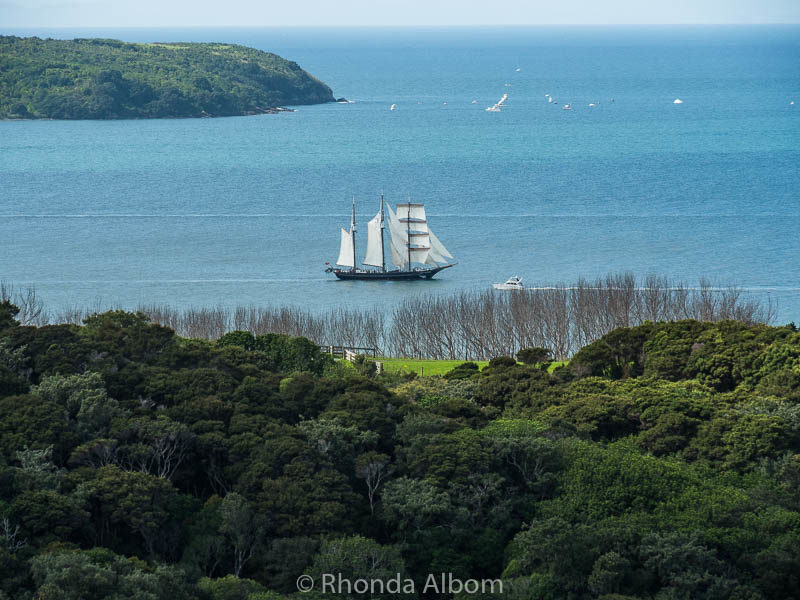
Save on your NZ trip with these resources
These are our go-to companies when we travel. We believe this list to be the best in each category. You can’t go wrong using them on your trip too.
- Flights: we use Expedia for the best and cheapest flight options.
- Accommodations: we use Booking.com (hotels), Bookabach (self-contained in NZ), or Hostelworld (budget).
- Cars (gas or electric): we use RentalCars to search for deals and dealer ratings.
- Motorcycles: we have heard good things about BikesBooking.
- Campervans or Motorhomes: we use Campstar where Albom Adventures readers get a 3% discount.
- Activity discounts: we check Bookme.com for discounts of up to 70% on activities.
- Private guides: we love the private guides at Tours by Locals.
- Travel Insurance: while not required, we always opt for travel insurance and start at InsureMyTrip to compare coverage plans.
Check out our travel resources page for more companies that we use when you travel.
Please Share

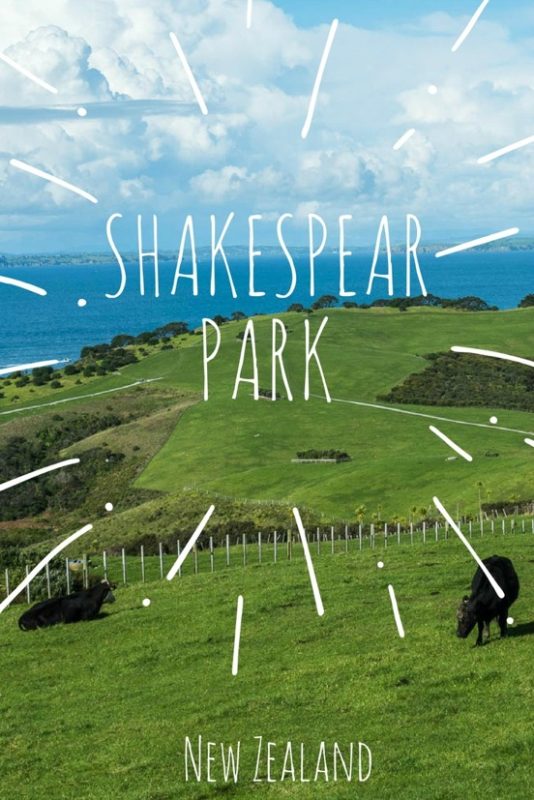
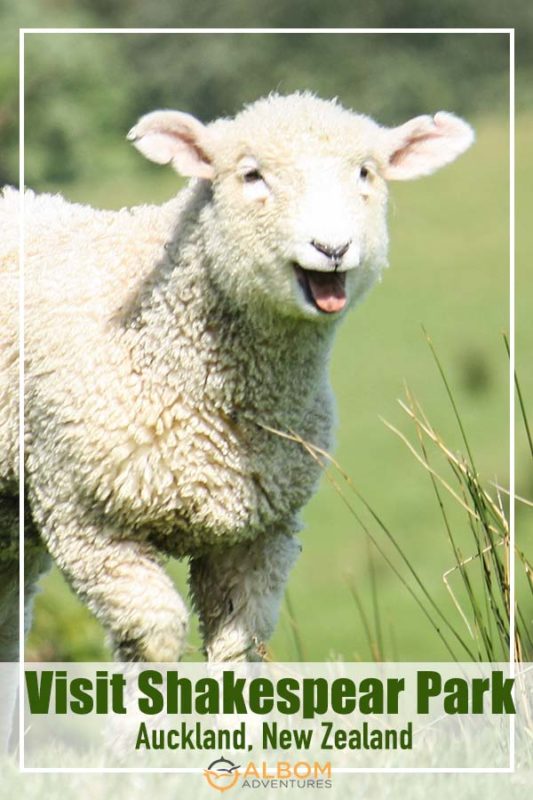
If you enjoyed this article, please share it on social media including Pinterest.
Have you been to Shakespear Park or any of the Auckland regional parks?
More from Auckland you might also like … starting with these 75 free and nearly free things to do in the city

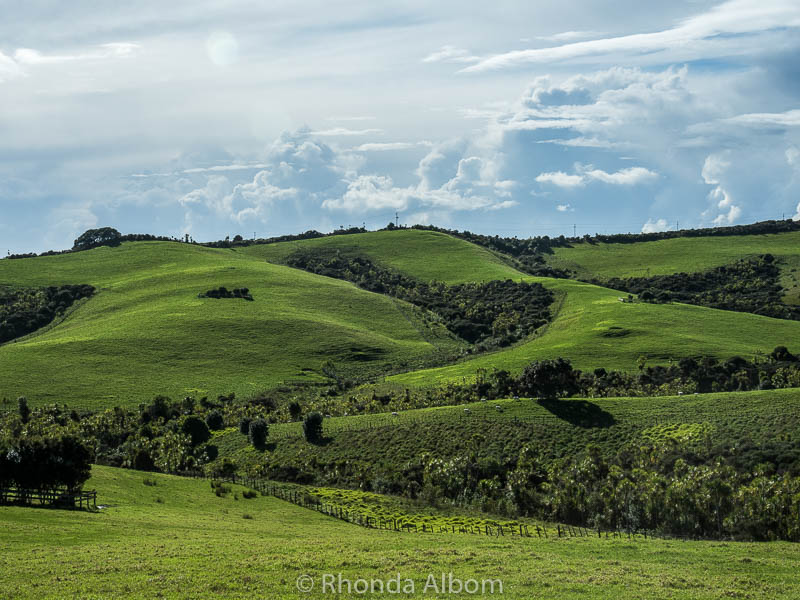






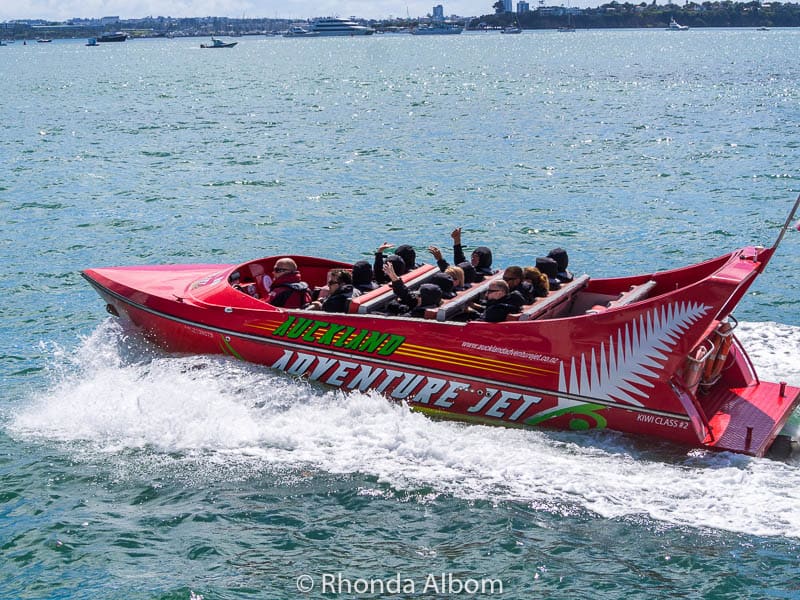
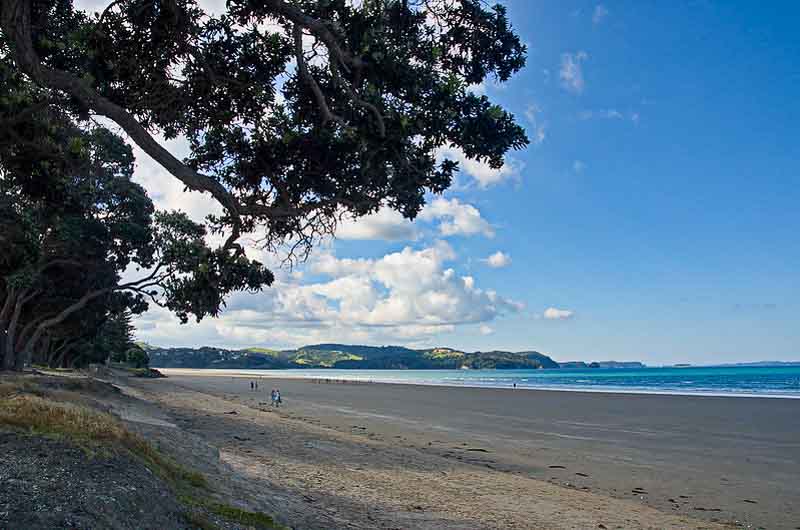

Paul Pietrangelo
There are some beautiful birds in New Zealand. Congratulations to your husband who you a very proud of for being one of the weekly volunteers. Keep safe my friends.
Cruisin Paul
Nancy
This looks like a marvelous place for a visit!!
Angela
Gorgeous photos! I wish we would have gone to this park when we were there in 2017. Maybe next time!
Lezley Perkins
What an amazing write up on our Beautiful Shakespeare Park, I’ve lived in Gulf Harbor for over 22 year’s and nowhere comes close to the paradise on our own front door….We probably take it for granted as we see it every day, but we are so lucky and it’s worth looking after, thankyou to all the people that take the time to look after it..
Kreete
Excellent information! I love that you can learn about sheep and cows and the hiking trails seem to be amazing too! And what a treat to have a chance to spot the kiwi bird! Thanks for sharing!
Rhonda Albom
Actually, there is very little chance we will ever see a kiwi bird, but we can hear them at night.
Janine Thomas
My friends have been on at me for ages to come and visit New Zealand. Shakespear Park looks fabulous. I love the shot of the spotted kiwis, very cute! I am going to bookmark this post for the future!
Megan Jerrard
Shakespear Park looks and sounds fabulous – love the lush green rolling hills – like something out of a fairytale! The baby lambs are adorable, but the biggest draw for us is that it’s a bird sanctuary – we’re big bird nerds though haven’t seen a kiwi bird in the flesh yet! Thanks for bringing this to our attention!
Rhonda Albom
It’s a fairytale I live every day. It is right across the bay from our house. Let me know when you head to the park.
Johann
Great to hear there are places where the community and the people work together to preserve some of these endangered animals. New Zealand has been on my radar forever and I’m hoping to put together a trip sometime soon. Hoping I get to see the country and its amazing landscapes that awe you.
Karla
I too get intimated by cows but I would still love to visit such a place. It’s really pretty. I also want to see the lambs
Rhonda Albom
It’s easy to be in the park and avoid the cows. But the truth is, they generally ignore us.
Divyakshi Gupta
The lambs are tooooooo cute!! <3 I could whisk one home! New Zealand has always awed me with its geographical diversity and beauty! This park with its beaches, trials, birds and pastures just is so inviting 🙂 Thank you for sharing this. Reading this on a gloomy day is a treat to the eyes:)
Rhonda Albom
LOL – the problem with taking home one of the lambs is that they grow quickly. They are only cute for a short time.
Anna @ shenANNAgans
The “green” of New Zealand is brilliant, I noticed that so many times when I was there, so great seeing it again in your pics. Wonderful that they released Kiwis too, I’ve only ever seen them in zoos.
Anda
I can see why Shakespear Regional Park is your favorite one, Rhonda. The scenery is absolutely stunning. It’s impressive that they built a predator-proof fence to protect the Kiwi birds. I love those baby lambs, but I also love cows. Interestingly enough, I’m intimidated by them too for some reason.
Rhonda Albom
I am actually more surprised by people who are not intimidated by cows.
Red Nomad OZ (Marion Halliday)
I had no idea Kiwis are so big! With so much variety, Shakespear Park sounds like it’s got something for everyone – especially keen birdos like us!! Although they’re cute, we’d most likely leave the lambs for the other visitors – there are plenty at home 😀
Rhonda Albom
Even though I see the lambs every year, I love them spend laming season at the park.
Holly
Very beautiful. It looks kind of romantic. Those baby lambs are the cutest ever!
Nuria Travelera
The scenery is beautiful, so green!! And these baby lambs how adorable, I want to take them home!
<3 <3 <3
Have a lovely week Rhonda
Leanne
Awww! Those lambies
Laura
I find the native wildlife of New Zealand fascinating… especially the birds! It’s amazing that 20 Little Spotted Kiwi birds were released 🙂 I visited Auckland last year but only for three days… Shakespeare Park is somewhere I’d definitely visit if I have chance to return.
knycx.journeyjng
A wonderful park and the sheep farm is just great. The baby lamps are very very adorable! Such a place and that’s open to public. 👍🏻 Nice! @ knycx.journeying
Rhonda Albom
The sheep are found all around the park. They move them to different paddocks as needed, but they don’t move them during lambing season.
Rajlakshmi
the hills look inviting. Such a beautiful place rich in flora and fauna. I hope I get to visit the place someday.
Tomas
It so nice park, but the kiwi… Have you seen it there?
Rhonda Albom
I was for a ceremony prior to the kiwi bird release. This is the only time I ever got to see (and touch) a kiwi bird in daylight.
Michelle | michwanderlust
The kiwi birds are so cute!! And the name is so confusing – is it a deliberate misspelling of Shakespeare or is there some other significance to the name?
Rhonda Albom
Shakespear is the name of the New Zealand family who donated the land. There is no relation to William Shakespeare.
Cyril
We have been to New Zealand once, but only travelled around South Island, we flew back from Auckland but did not have to leave the airport. Shakespeare Park sounds really great, loved the photo of the two lambs. We will definitely have to go back and do North Island sometime.
Rhonda Albom
The South Island is spectacular. There is plenty to see and do on the North Island. You will find lambs just about anywhere in New Zealand.
Indrani
What an interesting place this Shakespeare Park is! I love this kind of farm life.
The concrete jungle where I stay is so monotonous and boring. Cute lambs, I want to cuddle them. 🙂
Therese B
Ok – you’re making me a little homesick. We moved from Auckland to Australia in 1991 – I still get a kick in seeing how beautifully green everything is. We used to go to Orewa up near the peninsula regularly when I was a kid as my Uncle had a beach house up there. Also the Waiwera hot pools further north (don’t know if they still exist, Plus we used to go to a lot of the beaches along the peninsula to collect shellfish like pipis and cockles – they were so plentiful back then. Shakespear Park looks beautiful – and those lambs – how gorgeous. Think we need to do another trip back to NZ and revisit these places on a road trip.
budget jan
Goats are my favourite animals, but those two lambs are the cutest things ever. Looks like a great park – so green!
Ruth
This park is beautiful. I like those lush green hills. It is great to see the community involved in the conservation and enhancement of the park.
Rhonda Albom
I love going to the park and walking the trails. I occasionally come across some of the re-populated native species and this makes me smile.
Sharon
How I would love to hike here! I love the bridge in the trees . . .
Rhonda Albom
That is one of a couple of small bridges and boardwalks on the waterfall gully track.
Ryan Biddulph
Hi Rhonda,
Wow, how neat.
Seeing those baby lambs is a draw enough but knowing what the folks are doing for endangered birds makes it a fabulous spot definitely worth a visit.
I have not been to NZ yet – we should have done a quick trip heading back from Fiji a few years ago, but had to go home – but this place is noted in the mind, for the hours of hikes and all the fascinating wildlife. I am a sucker for wildlife; about my fave part of circling the globe.
Ryan
Rhonda Albom
The park is a real treasure. The sanctuary has reintroduced many species including kiwi birds. Hubby (a volunteer) said other volunteers were scanning the park at night for seabird species. They pointed a camera up and over a verge and had a pair of baby penguin eyes staring back.
Vanessa Brune
Omg, the lambs are just adorable <3 I'm always up for a hike – especially if it includes gorgeous landscapes and wildlife like this!
Rhonda Albom
They’re only lambs for such a short time but the rest of the park and its scenery is always there.
shere
the baby lambs are adorable!! I feel so sorry when I eat lamb 🙁
Alissa Apel
What’s not to love with rolling hills and baby animals?! It looks like a beautiful dream for sure.
jill
Beautiful! How about those baby lambs? Postcard picture cute!
Lolo
OMgoodness, this park is sooo beautiful! Love that there are baby sheep and adorable moo-moos! Stumbled
Rhonda Albom
I like the sheep and lambs but the cows make me nervous.
Tanja (the Red phone box travels)
beautiful park indeed:)
Andrea
Oh i want to go there, especially when you said it is just in Auckland. I wonder when i will visit NZ again, my sister is coming home Nov-Dec this year. She is a food company auditor and travels a lot, and i am wanting to tag along. While she is working i will be roaming around doing photography, oh what a lovely life if that is possible. Now i am looking at the map to see where that park is in relation to Auckland.
Rhonda Albom
The park is about 50km away from downtown Auckland. It is at the end of a peninsula and is accessible by public transit.
Hilary Melton-Butcher
Hi Rhonda – it does look a lush park … and what a wonderful place to have ‘just next door’ to you … to be able to wander in, enjoy, learn, and just generally take in the good views – a delight – cheers Hilary
Mary {The World Is A Book}
What a beautiful park! I love those baby lambs! It’s great to know that NZ has something like this and has something to protect the animals and birds. I love that there is an army of volunteers to take care of this place.
Rhonda Albom
New Zealanders take their native flora and fauna very seriously. Hubby is one of those volunteers.
Patrick Weseman
Very beautiful pics. New Zealand is such a beautiful land. Thanks for sharing these great pics and for hosting. Have a wonderful weekend.
Lyn aka The Travelling Lindfields
Our visit to Shakespear Park was brief but I thought it was a great place. One day I would like to come back and spend more time, especially exploring the hiking trails. I will let you know next time we are in New Zealand and perhaps you can be our guide again.
Sandee
I love all those critters, but the lambs are my favorite. They are so cute when they are little. Not so much when they are grown.
Have a fabulous day, Rhonda. ☺
Rhonda Albom
They’re little now. They were all born in about the last 5 weeks.
Katherine Vargas
gorgeous and so relaxing it looks.
Hilary
Hi Rhonda .. I’ve never been to NZ – but have some friends who live there … we walk the Downs here and have wonderful views once we reach the top … but those are spectacular … and you’re in Spring! Looking forward to seeing more sights in and around your home .. what a wonderful place to live next to: Shakespear park … cheers Hilary
Christine Rains
That’s gorgeous! I’d love to travel to New Zealand one day. I can’t imagine being afraid of sheep, but a whole herd of animals can be pretty intimidating.
Jennifer
Love that view of the coast!
L. Diane Wolfe
The sheep might run, but walk onto a field of cows near feeding time and you’ll discover you are quite popular.
Rhonda Albom
So far the cows have always left us alone. I am not sure they have feeding time here, as they graze all day. I really know very little about cows or sheep.
Agent 54
Wow, I’d love to visit New Zealand an Australia. Great pics.
Life with Kaishon
Awwwww! I love how sweet sheep look. My Mom’s Dad was a sheep farmer when he was young and he always said they weren’t the nicest animals. You could never tell by looking at them though, could you? You live in a beautiful part of the world. My fourth grade teacher was a missionary in New Zealand for about 12 years.
Rhonda Albom
They are cute, especially the lambs. It amazes me that they used to make me nervous. Glad to hear there might have been something to it.
wanderingeducators
what beautiful photos!!!
Donna
I was born and raised on a farm so was around animals all my growing up years. I think it’s great that the city has farm animals in its parks.
Andy
That’s cool the park is so close to you.
Steve
Love the post and photos Rhonda coming from and living in Central London all my life I rarely see the countryside I could almost breathe in the air from those pics
Jill
Beautiful countryside.